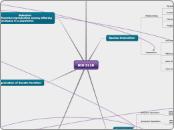BIO 311D
Species Interaction:
Relationships
Parasitism
when one organism benefits and the other one is harmed
Commensalism
when one organisms benefits and the other one is not harmed
Mutualism
both of the organisms benefit from the relationship
Predation
one organism depends on the other organism as a food source
competition
resources and habitat
fundamental niche
the resources and habitats that an organism can use or take up
Realized niche
the resources and habitats that an organism actually takes up
Males compete to reproduce with females
the male that best adapted will most likely be able to reproduce more than a male that is not very strong
allow for the most fit individuals to pass on their genes
resource partitioning
when organism focus on a speciic resource to reduce competition
Speciation:
species formation from a common ancestor
Allopatric Speciation
species formation from a common ancestor in geographically separate location
Sympatric Speciation
species formation from a common ancestor in the same geographical location
Evolution
Parallel
similar changes in the phenotype between two geographically isolated taxa (species, genera, etc.)
Divergent
accumulation of phenotypic differences between two lineages originating from a common ancestor over time
Convergent
development of phenotypic similarities between distantly related taxa over time
Character Displacement
when two organisms are headed towards each other based on resources but then swerve away in order to reduce competition
EX: finches on Gallapagos Island with different sized beaks
Population Regulation
Main factors that allow for population growth are food, medicine and sanitation
disease also affect the chances of survival of an organism
Population dependent factors
Mortality Rate
as population density increases the mortality rate increases
more densily populated ares are more prone to enconter disease and to cause it to spread
Birth Rate
as population increases birth rate decreases
amount of education of women also affects this
contraception has decreased the total births in recent years
Selection:
differential reproduction among differing phenotypes in a population
Natural Selection
Survival of the Fittest
selection is doe based on pheotype
ex: english moths that the birds were eating base on the ones that they could see, either white moths or peppered moths
Sexual Selection
Components: Males compete, Females choose
Selective forces acting on humans
Automatic abortion of monosomes, trisomes because fetus develops slower
environment selecting based on phenotypic traits
adverse weather conditions speed up evolution
Organization of Genetic Variation
Introduction of genetic variation
inbreeding depression causes many organisms to die off because of the lack of genetica variabiltiy
Genetic Rescue
The introduction of a closely related species into the endagered population to introduce more genetic variability in order to enhance chances of survival by reducing inbreeding depression
Mutations: random changes in genetic code
95% harmfull
4% neutral
1% beneficial
make new alleles
greates source of genetic variation
DIvergence from a common ancestro based on adaptation to the environment the organism was exposed to
polyploidy in plants allow for more gentic variation
Adaptive Radiation:
development of several new species from a common ancestor due to adaptations to different environments
Birds evolved from dinasaurs
developed active flight beginning with Arboreal. to leaping, to parachuting, to gliding, to active flight
Mammals evolved from reptiles
Whales are most closely related to Hippos
Homo Sapiens evolved from Ardipithecus 5 milion years ago
humans most closely related to chimpanzees with only 1.4% difference in genomic DNA
Species in habitats
generalized
have larger fundamental niches than realized niche
specialized
realized niche and fundamental niche are about the same size
are only able to live in very specific environments such as a canopy in a rainforest
